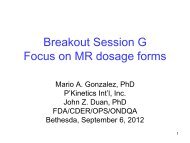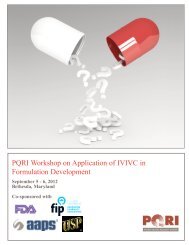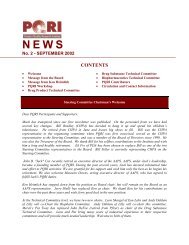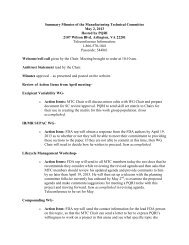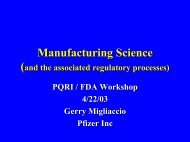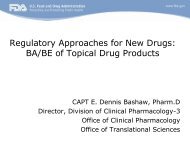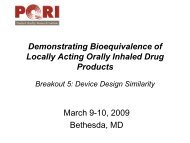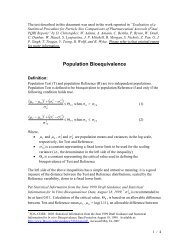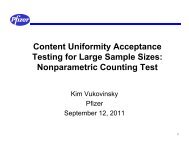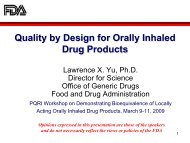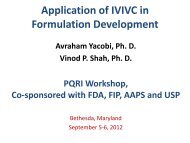IVIVC Industry Perspective with Illustrative Examples - PQRI
IVIVC Industry Perspective with Illustrative Examples - PQRI
IVIVC Industry Perspective with Illustrative Examples - PQRI
Create successful ePaper yourself
Turn your PDF publications into a flip-book with our unique Google optimized e-Paper software.
<strong>IVIVC</strong> <strong>Industry</strong><br />
<strong>Perspective</strong> <strong>with</strong><br />
<strong>Illustrative</strong> <strong>Examples</strong><br />
Presenter: Rong Li<br />
Pfizer Inc., Groton, CT<br />
rong.li@pfizer.com<br />
860.686.9440
<strong>IVIVC</strong> definition 1<br />
• Definition<br />
A predictive mathematical treatment describing<br />
the relationship between an in vitro property of<br />
a dosage form (usually the rate or extent of<br />
drug release) and a relevant in vivo response<br />
(e.g. drug concentration in plasma or amount<br />
of drug absorbed)<br />
1<br />
Guidance for <strong>Industry</strong>: Extended Release Oral Dosage Forms: Development, Evaluation, and Application of In Vitro/ In Vivo<br />
Correlations, September 1997<br />
2
Typical industrial applications of <strong>IVIVC</strong><br />
Primary Objective : Obtain Biowaiver<br />
- i.e. use dissolution test as a surrogate for pharmacokinetic data<br />
• Used as surrogate to bioequivalency studies which might typically be<br />
required <strong>with</strong> scaling up or minor post-approval changes (SUPAC), which<br />
may include<br />
– Site of manufacture<br />
– Formulation composition<br />
– Dose strength<br />
• To waive bioequivalence requirements for lower strengths of a dosage form<br />
• To reduce development time and optimize the formulation<br />
• Setting dissolution specifications<br />
• Recommended by regulatory authorities for most modified release dosage<br />
forms<br />
3
Basic steps towards establishing <strong>IVIVC</strong><br />
• In vitro<br />
– Dissolution: drug release as a function of time<br />
– Ensure same mechanism of release of drug from dosage form<br />
– Calculation of percent of drug release as function of time: Weibull<br />
• In vivo<br />
– Linear pharmacokinetics & knowledge of BCS category<br />
– Pharmacologic properties of the drug (Therapeutic Index)<br />
• Unit impulse function<br />
– Oral solution<br />
– Immediate release tablet/capsule<br />
– Population PK analysis<br />
– IV<br />
4
Basic steps towards establishing <strong>IVIVC</strong><br />
• Convolution<br />
The convolution method is a simulation method used to predict the<br />
blood/plasma concentration using percent absorbed data<br />
solving c(t) given f(t) and c δ (t)<br />
• Deconvolution<br />
Deconvolution is the process to obtain input function (percent absorbed)<br />
using known plasma concentrations<br />
t<br />
solving f(t) given c(t)and c δ (t)<br />
c( t)<br />
=<br />
∫<br />
f ( τ ) ⋅ cδ<br />
( t −τ<br />
) ⋅ dτ<br />
Deconvolution is the reverse process of convolution<br />
0<br />
% drug absorbed<br />
150<br />
100<br />
50<br />
0<br />
In vivo dissolution<br />
0 5<br />
Time (hrs)<br />
10 15<br />
Convolution<br />
Deconvolution<br />
PK profile<br />
5
Approaches undertaken to establish <strong>IVIVC</strong><br />
• Retrospective analysis of existing PK/dissolution data<br />
– Historical dosage development and PK data<br />
– Often full cross-over comparison of formulations is not available<br />
• Prospective planning & developing clinical study designs for<br />
establishing <strong>IVIVC</strong><br />
– Formulation scientists develop and provide:<br />
• Formulations <strong>with</strong> different release rates, such as slow, medium and fast<br />
• IV or oral solution or IR dosage form for unit impulse<br />
– Analytical scientists: obtain in vitro dissolution profiles<br />
– Clinical: in vivo plasma concentration profiles for these formulations<br />
– Money and Time<br />
6
<strong>Illustrative</strong> example: Compound A<br />
Problem statement: a single Level A <strong>IVIVC</strong> was accepted by<br />
regulatory agency for Compound A at dose X, can we request<br />
biowaiver for lower strengths<br />
Retrospective Analysis<br />
Matrix SR tablets<br />
BCS 1 compound<br />
% drug release<br />
120<br />
100<br />
80<br />
60<br />
40<br />
20<br />
0<br />
0 10 20 30<br />
Time (hrs)<br />
target<br />
release<br />
fast<br />
release<br />
Weibull Equation<br />
W<br />
= W t<br />
⋅ e<br />
( )<br />
−[(<br />
t−γ ) / τ ]<br />
−<br />
max<br />
1<br />
d<br />
W t : the fraction of drug dissolved/absorbed at time t<br />
W max : the maximum cumulative fraction<br />
dissolved/absorbed<br />
γ the location parameter (the lag time before the<br />
onset of dissolution)<br />
τ d : the time parameter (provides information about<br />
the overall rate of the process)<br />
β: the shape parameter<br />
β<br />
7
<strong>Illustrative</strong> example: Compound A<br />
% drug release<br />
120<br />
100<br />
80<br />
60<br />
40<br />
20<br />
0<br />
0 10 20 30<br />
Time (hrs)<br />
target<br />
release<br />
fast<br />
release<br />
Fraction Absorbed<br />
1<br />
0.8<br />
0.6<br />
0.4<br />
0.2<br />
0<br />
0 50 100<br />
Time (hrs)<br />
target<br />
release<br />
fast<br />
release<br />
%<br />
Retrospective Analysis<br />
Matrix SR tablets<br />
BCS 1 compound<br />
Cmax<br />
( obs)<br />
− Cmax<br />
( pred )<br />
PE C =<br />
× 100%<br />
max<br />
C max(<br />
obs)<br />
%<br />
<strong>IVIVC</strong> - Mathematical Relationship<br />
fraction of drug absorbed<br />
= A *(fraction drug dissolved B )<br />
Conclusion: the Level A <strong>IVIVC</strong> confirmed that<br />
the dissolution method developed for<br />
Compound A is sufficient to predict in vivo<br />
results for all dose strengths from 0.25*X to<br />
1*X mg. The correlation was used to justify<br />
dissolution specifications.<br />
Prediction Error<br />
Internal<br />
Validation<br />
External<br />
Validation<br />
%<br />
Formulation Parameter Absolute %PE Ratio<br />
1*X (target release)<br />
1*X (fast release)<br />
Avg Internal<br />
0.5*X dose (study 1)<br />
0.25*X dose (study 1)<br />
0.5*X dose (study 2)<br />
0.25*X dose (study 2)<br />
1*X dose<br />
PE AUC max<br />
=<br />
AUC<br />
max<br />
( obs)<br />
− AUC<br />
AUC ( obs)<br />
max<br />
max<br />
( pred )<br />
AUCINF 6.7 0.93<br />
Cmax (ng/ml) 2.3 1.02<br />
AUCINF 1.6 0.98<br />
Cmax (ng/ml) 1.1 1.01<br />
AUCINF 4.1 0.96<br />
Cmax (ng/ml) 1.7 1.02<br />
AUCINF 6.6 0.93<br />
Cmax (ng/ml) 5.7 0.94<br />
AUCINF 7.6 1.08<br />
Cmax (ng/ml) 4.5 1.04<br />
AUCINF 5.7 0.94<br />
Cmax (ng/ml) 5.6 0.94<br />
AUCINF 9.5 0.91<br />
Cmax (ng/ml) 2.9 0.97<br />
AUCINF 1.5 0.99<br />
Cmax (ng/ml) 5.3 1.05<br />
× 100<br />
8
<strong>Illustrative</strong> example: Compound B<br />
Problem statement: a single Level A <strong>IVIVC</strong> was accepted by<br />
regulatory agency for Compound B at dose X, can we extend<br />
the current <strong>IVIVC</strong> to higher strengths Can we use the <strong>IVIVC</strong><br />
to request biowaiver for the site changes<br />
• Compound B<br />
– Compound marketed at unit dose strengths of 0.5X mg<br />
and 1X mg<br />
– The 3X dose strength is currently registered and used as<br />
multiple units of X dose strength<br />
– New 3X single dose is currently in development<br />
– Similar dissolution profiles and characteristics in vitro<br />
over the dose range of X dose to 3X dose<br />
– Same formulation composition for Compound B over the<br />
dose range of X dose to 3X dose<br />
– Both C max and AUC increased in a linearly doseproportional<br />
manner over the dose range studied over<br />
the dose range of X dose to 3X dose<br />
Retrospective Analysis<br />
Matrix SR tablets<br />
BCS 1 compound<br />
=<br />
3 * X = 3X<br />
9
<strong>Illustrative</strong> example: Compound B<br />
Problem statement: a single Level A <strong>IVIVC</strong> was accepted by<br />
regulatory agency for Compound B at dose X, can we extend<br />
the current <strong>IVIVC</strong> to higher strengths Can we use the <strong>IVIVC</strong><br />
to request biowaiver for the site changes<br />
• Compound B extended release<br />
– Level A <strong>IVIVC</strong> was developed using a<br />
single release rate<br />
– Dissolution method is independent of<br />
disso conditions (pH, agitation and media)<br />
Retrospective Analysis<br />
Matrix SR tablets<br />
BCS 1 compound<br />
Predicted 3X dose<br />
fraction of absorbed<br />
= A *(fraction dissolved)+ B<br />
=<br />
3 * X = 3X<br />
Conclusion: In vitro-in vivo correlation (<strong>IVIVC</strong>) model<br />
predicted AUC and C max of Compound B at strengths<br />
up to and including 3X dose strengths, therefore<br />
biowaiver for higher dose strength is justifiable.<br />
10
<strong>Illustrative</strong> example: Compound C<br />
Problem statement: design clinical study to establish <strong>IVIVC</strong> based<br />
on existing development data for extended release tablets.<br />
Which is the preferred method to be used for deconvolution<br />
Do we need to include IR arm in the <strong>IVIVC</strong> clinical study<br />
Compound C<br />
• Typical (ideal)<br />
– Three or four formulations developed <strong>with</strong> differing dissolution profiles<br />
– Study in healthy volunteers<br />
– Three or four way crossover in 12 to 24 subjects<br />
– 2 or 3 formulations used to develop <strong>IVIVC</strong>, one arm of study for conducting external<br />
validation<br />
• Can we use Wagner-Nelson equation to perform deconvolution analysis<br />
Prospective Planning<br />
Matrix tablets<br />
BCS 1 compound<br />
• Can we use population based mean IR PK data to generate unit impulse response and<br />
perform numerical deconvolution<br />
11
Determining the fraction of dose absorbed<br />
• Model dependent methods<br />
– Wagner Nelson Equation (one compartment model)<br />
– Loo-Riegelman Method (multiple compartment models)<br />
• Model independent methods<br />
– Deconvolution<br />
F<br />
t<br />
=<br />
C<br />
t<br />
t<br />
+ k<br />
k<br />
∫<br />
el<br />
el<br />
⋅ AUC<br />
⋅ AUC<br />
∞<br />
0<br />
t<br />
0<br />
ct<br />
+ K10 AUC0<br />
+ ( X p ) t / Vc<br />
Ft<br />
=<br />
K AUC<br />
c( t)<br />
= f ( τ ) ⋅ c ( t −τ<br />
) ⋅ dτ<br />
0<br />
10<br />
δ<br />
t<br />
∞<br />
0<br />
X p ; the amount of drug in the peripheral<br />
compartment<br />
K 10 : the apparent first order elimination rate<br />
Response Impulse Unit impulse response<br />
• IV bolus<br />
• Oral solution<br />
• IR dosage form<br />
12
Compound C: deconvolution method<br />
Prospective Planning<br />
Matrix tablets<br />
BCS 1 compound<br />
Wagner Nelson Method<br />
Percent drug absorbed at any time<br />
% absorbed<br />
Fraction absorbed<br />
1.4<br />
1.2<br />
1<br />
0.8<br />
0.6<br />
0.4<br />
0.2<br />
0<br />
=<br />
C + k<br />
Wagner-Nelson<br />
(AUC from observed CR)<br />
0 5 10 15 20<br />
k<br />
e<br />
Time (hrs)<br />
e<br />
[ AUC]<br />
[ AUC]<br />
∞<br />
0<br />
t<br />
0 •<br />
100<br />
10011001<br />
10011002<br />
10011003<br />
10011004<br />
10011005<br />
10011006<br />
10011007<br />
10011008<br />
10011009<br />
10011010<br />
10011011<br />
10011012<br />
10011013<br />
10011014<br />
10011015<br />
10011016<br />
10011017<br />
10011018<br />
10011019<br />
10011020<br />
10011021<br />
10011022<br />
10011023<br />
10011024<br />
mean<br />
• Some subjects demonstrated flip-flop mechanism<br />
• Some subjects do not fit <strong>with</strong> one compartment model<br />
• % PE not acceptable<br />
Fraction absorbed<br />
1.2<br />
1<br />
0.8<br />
0.6<br />
0.4<br />
0.2<br />
0<br />
Numerical deconvolution from<br />
individual IR data<br />
t<br />
∫<br />
c( t)<br />
= f ( τ ) ⋅ c ( t −τ<br />
) ⋅ dτ<br />
0<br />
Numerical Deconvolution from individual IR<br />
10011001<br />
0 5 10 15 20<br />
Time (hrs)<br />
δ<br />
10011003<br />
10011005<br />
10011006<br />
10011007<br />
10011008<br />
10011010<br />
10011011<br />
10011012<br />
10011013<br />
10011016<br />
10011017<br />
10011018<br />
10011019<br />
10011020<br />
10011021<br />
10011022<br />
10011023<br />
10011024<br />
Mean<br />
• No model related restrictions on analyses<br />
• Excellent % PE<br />
13
Compound C (two release rates)<br />
Treatment<br />
Description<br />
A Fast dissolution Develop <strong>IVIVC</strong><br />
B Reference Develop <strong>IVIVC</strong><br />
C Immediate Release Develop <strong>IVIVC</strong><br />
Prospective Analysis<br />
Matrix tablets<br />
BCS 1 compound<br />
Deconvolution from individual IR data<br />
F abs = A* Diss(B*T vivo )<br />
o<br />
IVIVR developed using previous clinical Data<br />
Formulation Parameter % PE Ratio<br />
o<br />
o<br />
Two release rates<br />
Small PE errors (
Compound C (two release rates)<br />
Treatment<br />
Description<br />
A Fast dissolution Develop <strong>IVIVC</strong><br />
B Reference Develop <strong>IVIVC</strong><br />
C Immediate Release Develop <strong>IVIVC</strong><br />
Prospective Analysis<br />
Matrix tablets<br />
BCS 1 compound<br />
Deconvolution from mean IR data from previous studies<br />
o<br />
Small PE errors (
Outcomes of <strong>IVIVC</strong> for illustrative examples<br />
• Compound A<br />
– Successfully obtained biowaiver<br />
• Compound B<br />
– Biowaiver justification under review <strong>with</strong> regulatory agency<br />
• Compound C<br />
– No IR arm will be needed in the <strong>IVIVC</strong> clinical study use<br />
population based PK model for unit impulse<br />
– <strong>IVIVC</strong> design and protocol being prepared for pre-submission<br />
discussion <strong>with</strong> regulatory agency<br />
16
Challenges for establishing/developing <strong>IVIVC</strong>-<br />
Industrial perspective<br />
• Majority of focus is for modified release dosage forms<br />
– Obtaining multiple release rates while maintaining same release mechanism is not<br />
trivial for some compounds<br />
– GMP manufacturing, analytical testing, meeting dissolution criteria, etc. requires<br />
significant resources<br />
– Clinical studies <strong>with</strong> different release profiles preferably in cross-over design<br />
– Time and cost<br />
• What about <strong>IVIVC</strong> for immediate release dosage form especially for BCS 2<br />
– Potential approach/how to develop<br />
– Different particle size to achieve different dissolution rates<br />
– Develop oral solution formulation (unit impulse) that does not precipitate/crystallize<br />
during GI transit<br />
• Typically regulatory guidance require <strong>IVIVC</strong> to be conducted in fasted state, is<br />
it necessary for a compound <strong>with</strong> a label requirement to take it <strong>with</strong> food<br />
• Should there be standardized approaches to evaluating dose dumping based<br />
on MR technology used (matrix, osmotic, multi-particulates, etc.)<br />
17
Questions<br />
Rong Li<br />
Pfizer Inc. Groton, CT.<br />
rong.li@pfizer.com<br />
860.686.9440<br />
18



